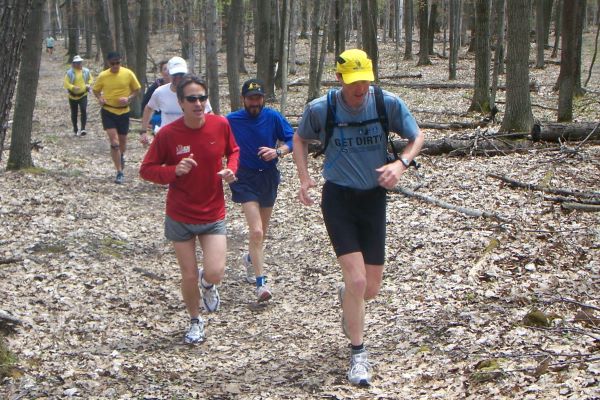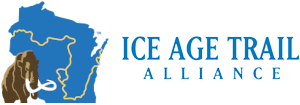
Annie Wiess (l) and Jason Dorgan (r). In 2007, trail runner Jason Dorgan set the first FKT on the Trail by running it in 22 days and 6 hours. In 2018, trail runner Annie Weiss broke the record and clocked her time at 21 days, 18 hours, and 7 minutes.
By guest writer, Rachele Krivichi
Since the late ‘90s, trail runners have been documenting their fastest trail runs under the moniker “FKT,” which stands for Fastest Known Time. The title implies that a person has run or hiked the trail faster than everyone before them. The tradition of FKT was started on the major hiking trails out west. However, in the past decade, a few runners have brought it home to the Ice Age Trail. In 2007, trail runner Jason Dorgan set the first FKT on the Trail by running it in 22 days and 6 hours. In 2018, trail runner Annie Weiss broke the record and clocked her time at 21 days, 18 hours, and 7 minutes. Mammoth Tales volunteer Rachele Krivichi spoke with both Jason and Annie to get their insights on accomplishing this challenge.
Rachele Krivichi: Why and how did you decide to run the trail? Did you have previous trail running experience?
Jason Dorgan: I started ultra-distance events in ‘94. It went from 50 miles to 100 miles, to Iron Man as I kept getting into the next thing. I started reading about Appalachian Trail runs and I was impressed by them. I knew I didn’t have time to do that kind of length, though. So, I started thinking why not try the Ice Age Trail? I realized no one had ever really tried to run it before. It was in my backyard, so I figured I’d better try to use it.
Annie Weiss: I participate in a lot of ultra-distance events, anything up to 100 miles. But running the Ice Age Trail, which was my husband’s idea, is the longest I’ve run. We had hiked a lot on the Holy Hill segment and got inspired to try the entire Trail. My goal was to essentially break the women’s record and then underneath it all I also wanted to break Jason’s record. There were days when I would run up to 75 miles, but we knew on average I had to do 50 miles a day to hit the record.
RK: What did you hope to accomplish by running the entire Trail?
AW: I’ve run Wisconsin races and I’ve run races out west and it really blows my mind how many runners, novice to pro, have never heard of the Ice Age Trail. So, mostly I wanted to bring light to the Trail. At first I wanted to promote it within the running community. But after I started, I was amazed by how many 9-13 year old girls followed along as I ran. I’ve done more talks with that age group since running it. I wasn’t trying to inspire that age group, but it was cool how that came out of it!
JD: Mostly, I wanted to experience the whole trail. I knew there would be sections that were more rugged than I’d previously thought. In addition, I also wanted to make my run into a fundraiser. I ended up raising about $15,000 for the Trail. It was kind of amazing how well I got the word out, because this was before Facebook. I ended up being interviewed and was on TV all across Wisconsin.

Jason Dorgan followed by a cadre of friends –Dave Sarocka, Roy Pirrung, Peter Wadsack, Brenda Bland, Kevin Radel, Vince Varone, and Ann Heaslett – who joined him for his final leg, a run through Potawatomi State Park, on his way to the Eastern Terminus of the Ice Age Trail. Photo by Tim Yanacheck.
RK: What did you learn about yourself in the process?
JD: I learned that it was possible for me to come back after hitting the low point. I had a plan to finish in three weeks. But sometimes, every step was painful, and I would need a pep talk from someone in my crew. So, the mental part of it was, “Yeah, this hurts, but I gotta push through it.” The last week was probably one of the easiest parts to do. I even felt like I could have run a few more days. But mentally, I was done. A week later I ran the Ice Age 50, the race down in Whitewater. But after that I took two months off from running.
AW: I think running the Ice Age Trail was a really good learning experience in being alone. Yeah, I might have had a runner with me sometimes, but I had so much alone time overall. So, I learned how to be with myself. I also learned that, even though my pain tolerance is already pretty high, I can handle more than I previously thought.
RK: What did you learn about the Trail?
AW: There are a lot of segments of the Trail that I had never run before that I really enjoyed. I was thoroughly impressed with the West Bend segment. It made me wonder why there isn’t a race there. I also learned there are a lot of road segments but that the Trail is really well marked. There were three occasions where I got turned around, but otherwise I had no problems. The volunteers really do a good job in maintaining the Trail.
JD: In hindsight, I realized how much effort it takes to maintain the trail. Before I started running, a chapter coordinator in the Northwoods heard about my run and warned me there was a place where the bridge was out. He made a temporary bridge with logs so I could run across it without getting soaked. I learned that nothing happens without the chapter, they’re so intimate with what’s in their area. It’s a small group of people that really make the Trail happen.
RK: How have you been shaped by the experience of running the Trail? Did it change you?
JD: It strengthened a lot of my core values. I’ve come to realize that, even though I ran this thing, I didn’t do it alone. Nothing is possible alone. I personally had a lot of good support. My overall philosophy of life is that you’ve gotta give back and help people. Even though it looks like a person accomplished something alone, all by themselves, that’s not a true perception.
AW: It proved to me that I like competing against myself. I’ve gotten into a stage where I don’t want to compete against other people; I’d rather just enjoy my time with them. So, this was a different kind of competition

Annie Weiss is radiant in her proud moment. She and her crew, Kevin Cannaday and Ryan Norton, reached the Eastern Terminus on September 30th at 12:56 am. Annie set the new Fastest Known Time record of 21 days, 18 hours, and 7 minutes, besting the previous record by 11 hours and 53 minutes. Photo by Brian Frain.
RK: How have you engaged with the Trail (or Alliance or chapters) since your run?
AW: My husband and I belong to the Ice Age Trail Alliance. We also plan to participate as Field Editors for the 2020 guidebook because they don’t have as many volunteers in the northern part of the state. So, we wanted to help up there. I’m also doing a few different presentations for different chapters in the next few months. I love doing that kind of stuff.
JD: I was on the board for six years and I’ve been doing the Mobile Skills Crew events since 2008. I had also been to the 2006 annual conference before running the Trail, and now attend almost every year. Also, I maintain and mow a 2.5-mile section of Trail near Verona. I also joined the Yellow Blaze Club to help support and fund the Trail. So, that’s how I give back now.
Rachele Krivichi is a writer, artist, and outdoor lover from Wisconsin. Her work has been seen in Wisconsin Gazette newspaper, Temporary Art Review, and Culturaal blog, based in the Netherlands. In 2016 she finished her first book, a study of camper and recreational vehicle culture. She recently moved to Minneapolis, but Wisconsin and the Ice Age Trail are some of her earliest loves.
